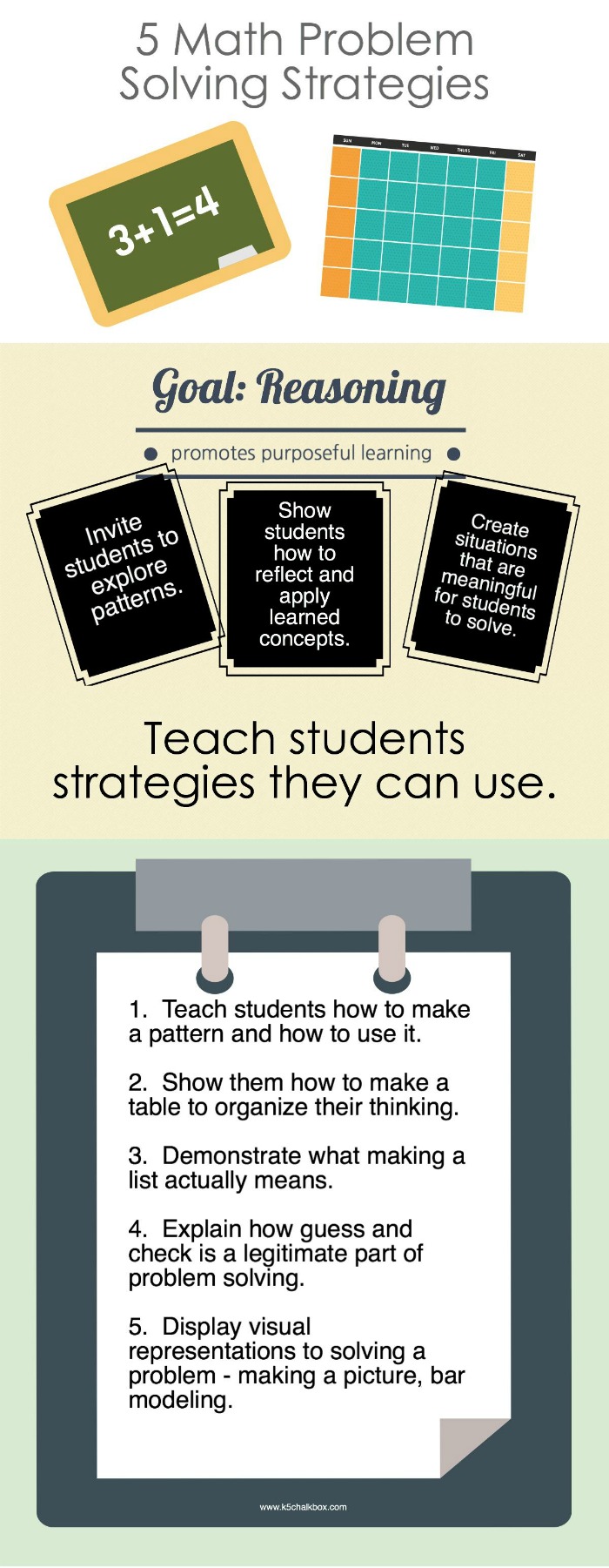Problem solving strategies must keep the focus on the “thinking” that is occurring. Math is often about a variety of skills and processes, but how we creatively use those skills is what leads us to finding solutions for difficult situations.
When we “coach” our students through different problem solving puzzles, we are allowing them to develop their mathematical thinking.
The students take charge of their learning and construct personal ideas about mathematics.
We can’t expect students to solve every problem with numbers. In fact, that can be counter-productive.
The infographic above is showing some methods (strategies) for finding the solution to a problem. These are the means to an end, and are often used in conjunction with each other.
(Scroll down for more information about each one).
These strategies (methods) are not inherently understood by many students. We simply have to teach them. They are the second step in Polya’s four stages to problem solving:
- Explore and reach an understanding of the problem
- Find a method or strategy/strategies to use
- Utilize the chosen strategies
- Look back and reflect on your solution
There is a danger in over-simplifying each step. None of these are simple and rarely will students move through each step consecutively.
Most of the time they will move around in the steps as they refine their thinking and their solutions.
Children need to experience how to deal with math problems on their own terms and in concrete ways before moving to the abstract.
They also need a chance to talk about their math discoveries and share insights with each other. That’s when they refine and extend their thinking.
Our role is to continually be “helping students construct a deep understanding of mathematical ideas and processes by engaging them in doing mathematics: creating, conjecturing, exploring, testing, and verifying” (Lester et al., 1994, p.154).
Elementary Problem Solving Strategies
At the core of solving math problems is the necessity to have a deep foundation in number sense. From there, students begin to apply that understanding to basic word problems and often begin using a Model Drawing approach.
A Model Drawing is simply a pictorial representation that helps students internalize and visualize math.
To differentiate, begin to encourage students to label their drawings. Remember that drawings do not need to be perfect; they just need to clearly show their thinking.
These are other heuristics, or methods for solving a problem. Students must be taught how to use a variety of methods to solve the same problem.
Only then can we see the results of their conceptual understanding of applying mathematics.
1. Make A Pattern
When we tell elementary students to make a pattern, they often do not understand. Essentially, a pattern is a figure that repeats itself, such as a number or word. It is best to use manipulatives to study pattern making to provide a concrete understanding.
There are two basic types of patterns: repeating and growing. A repeating pattern has an identifiable core that repeats over and over, such as ABACABACABAC.
A growing pattern repeats a mathematical process that makes the figure or number grow. Fibonacci numbers are a great example of growing patterns and are found throughout nature.
2. Make A Table
Often a table is used to help organize information found in Making a Pattern. A table helps to quantify a pattern so students can visualize the growing numbers.
Students note changes in stages and explain how the change in the table is occurring. This is done by identifying the repeating element.
You can use picture books to support teaching how to make a table. A fun one that children love is Two of Everything. Here is an elementary problem solving worksheet to go with it: Magic Pot table (courtesy of MathWire.com).
Another classic picture book for math is One Grain Of Rice: A Mathematical Folktale. Use the One Grain of Rice Worksheet to teach math problem solving with the book.
3. Make an Organized List
When we talk about making a list as part of problem solving strategies, we generally refer to a Tree Diagram.
This is important because part of efficient problem solving techniques is to not make random guesses.
A tree diagram is useful to determine the number of given outcomes (possibilities) from a set situation.
You can tell the children that the trunk of the tree is the problem. Each variable is a branch. Little branches grow from larger branches, and to calculate the final answer you only count the final number of little branches.
4. Guess and Check
This is one of the more difficult maths problem solving strategies for children to understand, but is often one of the first taught and used.
They get the “Guess” part but have difficulty with the “Checking.” Often they aren’t sure what they are checking for.
You can always point out that a good way to check an answer is to re-read it and see if it actually makes sense. Is the given answer actually possible?
The guess and check problem solving techniques helps students to think logically, make predictions and use mathematical equations. It all leads to deeper understanding.
5. Draw a Picture
Drawing a picture is a problem solving technique that has students make a visual representation of what the problem is. It really helps solidify concrete thinking.
Drawing a picture is the step between the visual and symbolic language of math. Pictures and diagrams are problem solving strategies that many students learn at the earliest stages of math development.
This is a good strategy as it is a way to communicate mathematical thinking. With just a bit of encouragement, most students will draw pictures.
